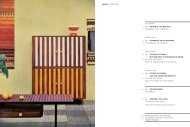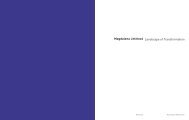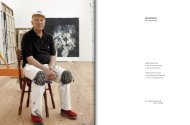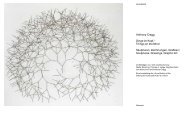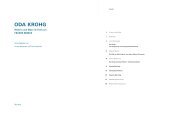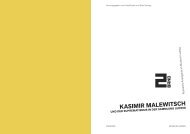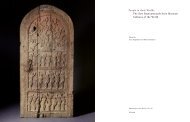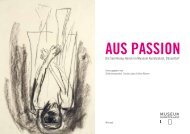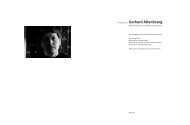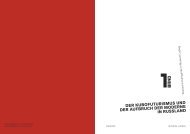ERIK BULATOV ſŲŪŬ ţŵŭŢŴŰŤ
ERIK BULATOV ſŲŪŬ ţŵŭŢŴŰŤ
ERIK BULATOV ſŲŪŬ ţŵŭŢŴŰŤ
Create successful ePaper yourself
Turn your PDF publications into a flip-book with our unique Google optimized e-Paper software.
8<br />
BREAKTHROUGH TO FREEDOM<br />
Yevgeny Barabanov<br />
freedom is<br />
freedom is<br />
freedom is<br />
freedom is<br />
freedom is<br />
freedom is<br />
freedom is freedom<br />
Vsevolod Nekrasov<br />
Erik Bulatov is a central figure in Russian contemporary art. The reassessment<br />
of the tasks of painting he undertook half a century ago<br />
led him, along with other enthusiasts who followed in his wake, to a<br />
new view of the artistic profession, modernity, and art itself. Although<br />
the epithet “classic” is now attached to his name, the ultimate significance<br />
of this reassessment itself, as embodied in Bulatov’s artistic and<br />
theoretical legacy, has not yet been exhaustively interpreted by researchers.<br />
One thing is irrefutable: with his original art, Bulatov has<br />
accomplished the impossible. He took up the challenge of the Soviet<br />
modernity he was confronted with and, without hiding from it, without<br />
turning away from the totality of its indoctrination, opened doors<br />
into a world of freedom, into a world that enabled him to link art’s past<br />
with its future.<br />
It has been at the crossroads of the classical past, the avant-garde,<br />
ideological kitsch, and innovation that the problematics of Bulatov’s<br />
art – the problematics of the picture – has been tested.<br />
The question of the picture remains suspended in today’s critical<br />
consciousness. For some critics and artists, the picture is a commercial<br />
product that has outlived its age. For others, it is an arbitrary object just<br />
as arbitrarily dubbed “picture.” For still others, it is an occasion for simulative<br />
practices. For Bulatov, however, the picture continues to be part<br />
of a basic experience of trust in the world, with all the existential, ontological,<br />
cultural, and anthropological implications that follow from<br />
that trust. For Bulatov, the picture is a foothold, an opportunity for<br />
encounter, dialogue, recognition, understanding, and self-knowledge.<br />
The absence of naïveté in this stance, a naïveté that from the<br />
outset has been deflected by a consistent theoretical self-consciousness,<br />
has often moved Russian critics to detect in Bulatov’s work<br />
“ludic strategies” combining the techniques of, say, photorealism<br />
with the constructivist poster or mass media production. Moreover,<br />
the thematics of his pictures and the presence therein of elements of<br />
Soviet propaganda have long been interpreted in terms of Sots Art. 1<br />
Hence, Bulatov has been ranked both among the modernists and the<br />
postmodernists. 2<br />
Here we should immediately note that what Erik Bulatov was<br />
the first to undertake on the eve of the 1970s was of course not Sots<br />
Art, neither in the sense that it acquired in the subsequent ventures<br />
of Komar and Melamid, nor in the sense of a combinatory polystylistics,<br />
a masquerade-like doubling that employs fictional “artists”<br />
as its “characters” (a program absent in Bulatov’s work), nor in the<br />
sense of a Bakhtinian “carnivalization,” that is, a grassroots culture of<br />
folkloric jokes made at the expense of ideological symbols. In Bulatov’s<br />
work, the social dimension is represented in all seriousness: he does<br />
not employ an alien idiom to mock it. There is no irony in his work;<br />
irony is replaced by distance, by a viewpoint that enables him to see<br />
and recognize things, to give them names and images. Bulatov is not<br />
an eclecticist, and therefore his work is bereft of postmodernist pastiche,<br />
simulacra, and imitations of classicism. For him, the picture is<br />
an opportunity to defend the reality of art on the frontier between life<br />
and its devastation.<br />
The seriousness with which Bulatov has taken the theoretical<br />
bases of his stance has encouraged attempts to rank him among the<br />
conceptualists. 3 If what is meant here is concept art, then he makes<br />
no attempt to situate his art “after philosophy,” that is, after the philosophy<br />
of art, after the aesthetics of the painting, as Joseph Kosuth<br />
called on artists to do. Bulatov has never tried to replace the traditional<br />
image with its technical counterpart, to replace the colored pencil<br />
or paint brush with extra-pictorial realia – with texts, photographs,<br />
objects or actions. On the contrary, he has consistently defended the<br />
value and relevance of the picture. He has done much to overcome the<br />
aestheticism and aestheticization of “French painting,” but he considers<br />
the denial of aesthetics itself naive. 4<br />
It is obvious that instead of the empty and, in our case, meaningless,<br />
one-size-fits-all word “conceptualism,” it would be more correct<br />
to speak of conceptualization – that is, of the construction of particular<br />
models of pictorial space vis-à-vis the picture as thing and the perceptual<br />
experience of the picture’s artistic world. This perhaps sounds<br />
a bit old-fashioned, but it brings us noticeably closer to the essence of<br />
the matter, to the intentions, tasks, and problems that Bulatov himself<br />
is concerned with.<br />
1 See Margarita Tupitsyn, “Sots Art: The Russian Deconstructive Force,” in Margarita<br />
Tupitsyn, et al., Sots Art, exh. cat. New Museum of Contemporary Art, New York, et al.<br />
(New York, 1986), pp. 4–15 [on Bulatov pp. 7–8, 106]. The characterization of Bulatov<br />
as Sots Artist can also be found in concise form: “Erik Bulatov is today considered a leading<br />
representative of the so-called ‘Sots-art.’” Eric A. Peschler, Ateliers de Moscou: Dessins<br />
contemporains (Paris: Enrico Navarra – Galerie de France, 1989), p. 37.<br />
2 Е. Andreeva, Postmodernizm. Iskusstvo vtoroi poloviny XX–nachala XXI veka (Saint<br />
Petersburg: Azbuka-Klassika, 2007), pp. 210–211.<br />
3 “Bulatov is one of the key names in Moscow conceptualism.” I. Kulik, “Govorit i pokazyvaet<br />
Erik Bulatov. Retrospektiva zhivopistsa-nonkonformista v Tret’iakove,” Kommersant,<br />
September 21, 2006, p. 13.<br />
4 V. Tupitsyn, “Erik Bulatov,” in V. Tupitsyn, “Drugoe” iskusstvo. Besedy c khudozhnikami,<br />
kritikami, filosofami: 1980–1995 gg. (Moscow: Ad Marginem, 1997), pp. 66–67.<br />
We should remember that we are dealing with a wholly original,<br />
tremendously important artist who has achieved a supreme level<br />
of artistic maturity, definition, perfection, and formal precision. In<br />
Bulatov’s work, there is none of the coyness, ambiguity, pretentious<br />
striving after literary effects or mystical fogginess that in contemporary<br />
art so often conceals an ambitious incompetence. On the contrary,<br />
Bulatov is an artist capable of formulating general problems<br />
and articulating his own tasks with utter clarity and responsibility.<br />
The same can be said of his system of self-interpretation, which is<br />
least of all a makeweight to the work itself. Its function is to limit all<br />
forms of indeterminacy, and that is why it is directed both towards<br />
integration and differentiation. And because any form of integration<br />
consists of differentiations, Bulatov is particularly attentive to the latter.<br />
Moreover, the system of differences he has introduced encompasses<br />
not only the specifics of the works themselves, but also the premises<br />
and rules of their hermeneutics, which are generated in dialogue with<br />
the picture, with tradition, with the viewer. The agency of the viewer<br />
is particularly important: Bulatov’s system of unities and differences is<br />
an open system albeit one that seems, to some, paradoxical; however,<br />
it excludes all ambivalence. Hence, the desire to reduce indeterminacy<br />
also gives rise to more basic distinctions signaled to the outside world,<br />
to those negative self-definitions on which Bulatov never tires of insisting:<br />
that his work is not modernism, not Sots Art, not hyper- (or<br />
photo-) realism, not mass media.<br />
We should begin our brief resume of Bulatov’s life with this elucidatory<br />
“not.”<br />
1. MOSCOW – PARIS<br />
Bulatov is not from the Urals. Although he was born in Sverdlovsk<br />
(now known as Yekaterinburg) in 1933, his parents were Muscovites.<br />
After his father returned to the capital from an assignment in<br />
Sverdlovsk, Bulatov grew up, studied, and then worked in Moscow<br />
right up until his emigration from the Soviet Union in the late 1980s.<br />
From 1947 to 1952, he studied at the Moscow Arts Middle School<br />
(MSKhSh) and after graduation in the painting department at the<br />
Surikov Art Institute in Moscow. These educational institutions remained<br />
the most prestigious strongholds of Soviet academic art right<br />
up until the fall of communism.<br />
However, the decisive role in Bulatov’s formation as an artist was<br />
played by two men – the painter Robert Falk (1886–1958), whom<br />
Bulatov met in 1952, and Vladimir Favorsky (1886–1964), a graphic<br />
artist, master book illustrator, original thinker, and art theorist whom<br />
Bulatov met in 1956.<br />
Both Falk and Favorsky emerged as artists during the avant-garde<br />
period. Later, during the 1920s, both men taught at the renowned<br />
Vkhutemas/Vkhutein in Moscow. Finally, both were denounced as<br />
“formalists” by semi-official doctrinaires and shunted to the sidelines<br />
of artistic life. Recognition of their significance, role, scale, and<br />
indisputable achievements in Russian art came only gradually, with<br />
the advent of the Khrushchev Thaw. Both Falk and Favorsky formed<br />
original artistic systems based on a profound knowledge of the latest<br />
tendencies in European art, as well as a critical reassessment of them.<br />
Favorsky studied in Munich in 1906–1907 and, later, in the art history<br />
department of Moscow University; he translated the theoretical<br />
texts of the sculptor Adolf Hildebrand as well as Karl Voll’s book<br />
Comparative Studies of Paintings. 5 Falk, an adherent of Cézanne and<br />
the Cubists, was a member of the Jack of Diamonds group. Later,<br />
from 1928 to 1937, he lived and worked in Paris, where he had been<br />
sent originally (for a much shorter term) to study “classical art.” This,<br />
however, did not prevent him from becoming intimately familiar<br />
with all the significant phenomena in the artistic life of this period.<br />
Falk’s conversations with the student Bulatov, and their viewing<br />
and critique of work (this all began while Stalin was still alive!) were<br />
a defining moment for Bulatov. “I essentially got my understanding<br />
of French art (and all French culture in general) from Falk. But perhaps<br />
what was more important was that Falk became for me an exemplar<br />
of how the artist should conduct himself in social space. He<br />
had no opportunity to exhibit his works, and as an artist he lived in<br />
total isolation. Official critics pretended that there was no such artist.<br />
And without fuss, without becoming indignant, without trying<br />
to adapt, not reacting to anything, he went on with his work, peaceful<br />
and focused. I think that Falk was the only member of his generation<br />
of artists who not only did not regress during those years, but, on the<br />
contrary, worked better than he previously had.” 6<br />
Bulatov continued to master Falk’s painterly principles and, occasionally,<br />
up until 1961, to imitate his manner. Thereafter, and right<br />
up to the present day, the place of the teacher in Bulatov’s life has been<br />
occupied by Vladimir Favorsky. For Bulatov, it was no longer a matter<br />
of overcoming the deadening academicism of socialist realist painting<br />
as much as it was a matter of developing his own problematics, his own<br />
artistic system.<br />
Bulatov did not imitate Favorsky, nor did he even show him his<br />
works. Instead he would go to the patriarch of Moscow art to ask questions.<br />
The master’s answers, which were grounded in his own artistic<br />
practices, a profound analysis of the spatiality of artworks, and, finally,<br />
his rich experience as a teacher, introduced Bulatov not so much to<br />
readymade solutions as to methodological self-consciousness, to a clear<br />
sense of one’s own work and the how, what, and why of the work done<br />
by others. Under Favorsky’s tutelage, Bulatov mastered and rethought<br />
principles, not techniques.<br />
Bulatov’s encounter with Falk and Favorsky marked the beginning<br />
of a thoroughgoing process of re-education – a conscious overcoming<br />
of the doctrines and methods of socialist realist painting. Along with<br />
this re-education, Bulatov formulated his own problematics as an artist:<br />
the problematics of the picture as a multi-dimensional spatial universe.<br />
This was least of all a quest for formal solutions. The question of<br />
the picture – its potential, place, and role in art – became the content<br />
of Bulatov’s life, a means of self-understanding, a way to reflect on existential,<br />
metaphysical, and social questions. It goes without saying that<br />
this interpretation of the picture and his own mission in life inevitably<br />
distanced him from a successful career as a Soviet painter.<br />
5 A. Gil’debrand, Problema formy v izobrazitel’nom iskusstve, trans. N. B. Rozenfel’d and<br />
V. A. Favorskii (Moscow: Musaget, 1914) [Russian translation of Adolf Hildebrand,<br />
Das Problem der Form in der Bildenden Kunst (Straßburg: Heitz, 1901)]; K. Foll’, Opyt<br />
sravnitel’nogo izucheniia kartin, trans. N. B. Rozenfel’d and V. A. Favorskii (Moscow:<br />
Izdatel’stvo G. A. Lemana i S. I. Sakhorova, 1916) [Russian translation of Karl Voll, Vergleichende<br />
Gemäldestudien (Munich: Müller, 1907)].<br />
6 E. Bulatov, “Avtobiografiia,” in E. Bulatov, Zhivu dal’she (Moscow: Artist. Rezhisser.<br />
Teatr, 2009), p. 12.<br />
9




